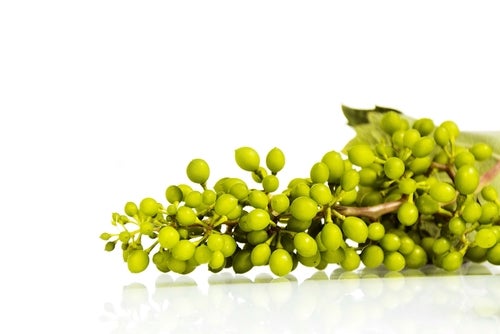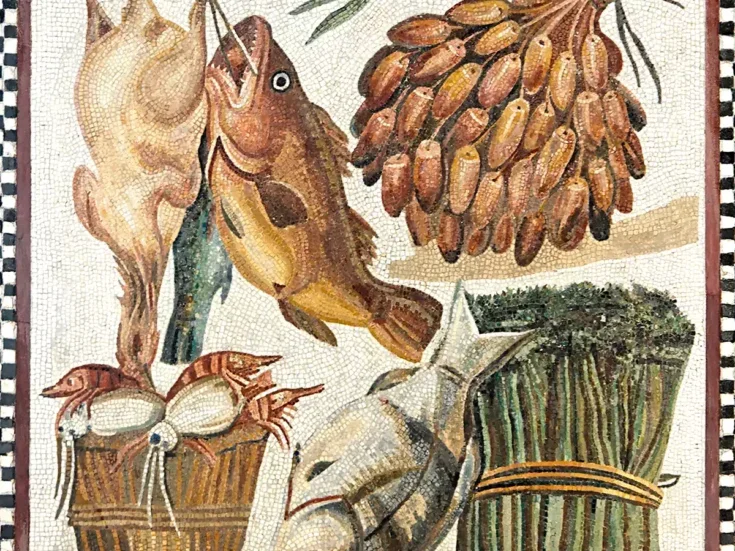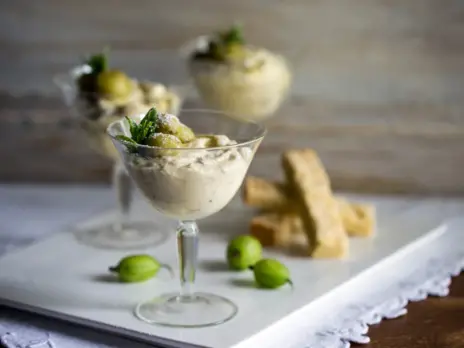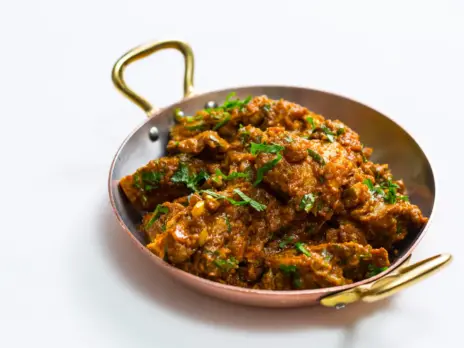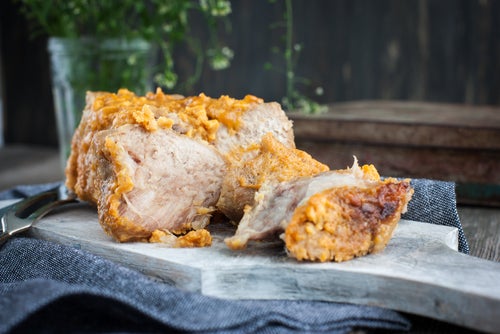
Pork cooked in milk is not something you are likely to find in a Michelin-starred restaurant, even under one of the dish’s more euphonious, to an Anglosaxon ear, Italian, French, or Spanish names. This has nothing to do with its flavour and everything to do with its looks. Not only is the color a rather unappetising brownish cream-cum-beige, but the sauce is essentially curdled milk. Anyone brought up on English nursery rhymes may like to think of it more nostalgically as curds and whey, as in “Little Miss Muffet sat on her tuffet eating her curds and whey.”
Elizabeth David, whose recipe for maiale al latte in Italian Food was probably the first notable version in English when it was published in 1954, describes the sauce as having “grainy little pieces.” Others have described them as “nutlike clusters” and “brown nuggets.” Some are less flattering. Francine Claustres in her recipe for carré de porc à la basquaise in Connaître La Cuisine de Sud Ouest (Éditions Sud Ouest, 1996) writes crisply that the milk changes in color in cooking and becomes lumpy and thick (grumeleux et epais), but she assures us that it will be“délicieuse.”
I’m reminded of the appearance of scrambled eggs that have caught slightly and been scraped from the bottom of the pan, but I agree with everyone’s sentiment that both the pork (tenderized by the lactic acid in the milk) and the sauce are delicious. I also agree with those, among them Elizabeth David, Paula Wolfert (The Cooking of South West France, 1983), and Claudia Roden (The Food of Spain, 2011), that this is a dish that is good hot or cold. In fact, Elizabeth David, says she thinks it “best cold.” Certainly, at this time of year I prefer it cold.
Elizabeth David gives no source for her recipe, but it may have been the one in Pellegrino Artusi’s influential 1891 cookbook La Scienza in Cucina e l’Arte di Mangiar Bene, the 50th edition of which she includes in a list of Italian cookery books in Italian Food. And it’s possible that Artusi’s is the first written recipe, as was his vitello tonnato, but, as you will have gathered, pork cooked in milk is a dish of more than one region and country.
Italy, where it is often called arista di maiale al latte, indicating loin as the cut, has the most recipes, but no one region has been able to claim it definitively as its own. The Veneto is often cited, but so, too, is Emilia-Romagna, namely the epicurean city of Bologna. Claims are also made for Friuli-Venezia Giulia in the far northeast, Tuscany’s capital, Florence, and the southern cities of Naples on the west coast and Bari on the east coast.
In France, it clearly comes from the southwest. Paula Wolfert, who introduces her recipe, porc frais au lait (frais meaning fresh, to distinguish it from salt pork) by acknowledging a “somewhat similar” Venetian dish. She then goes on to say that she is not sure where in the southwest the recipe originated but that it appears prominently in Maïté Escurignan’s work on Basque cookery (Manuel de Cuisine Basque)—and Francine Claustres, with her porc à la basquaise, is firmly in that region.
Interestingly, Claudia Roden’s recipe in The Food of Spain is in the regional chapter on Navarre and the Basque country, just across the border, and she also introduces it by saying, “I had once eaten pork cooked in milk in Venice.” Her recipe, however, has an important difference from the Italian and French recipes: the pork loin is cooked in milk with caramel (lomo de cerdo con leche y caramelo) the caramel made with a not insignificant six tablespoons of sugar. But, she adds: “For a Spanish version of the dish […] simply omit the caramel step at the end.”
How to make pork cooked in milk
Caramel apart, the variations and tweaks to the dish are relatively minor. The simplest of recipes consist of pork loin (or sometimes shoulder), fat for browning the seasoned meat, although some don’t even brown it, and enough hot milk to cover it either completely or about three-quarters of the way up, in a heavy-based pan or Dutch oven into which the pork fits snugly. It is then simmered gently in the milk, uncovered or partly covered by a lid, for one-and-a half to two hours until the meat is tender and the sauce is a curdled reduction ready to be served with slices of the pork (sometimes the sauce is reduced further first).
Most recipes include garlic cloves and a fresh herb, most commonly sage, and many include lemon rind (l use the rind of one lemon pared into strips, four halved cloves of garlic and I sometimes use fresh bay leaves instead of sage). A few recipes include diced onion and ham/prosciutto browned with the meat.
I am still, after many years of making this dish, surprised at how many different kinds of wine it welcomes with open arms—and not just white wines that some people assume are the obvious fit. I should say I am not including Claudia Roden’s caramel version here because it is a bit of an outlier and, although she describes it as having a “beautiful flavor,” I am less keen.
The best wines to pair with pork cooked in milk
Spanish wines do, however, provide some of my favourite matches. But before I come to those, it’s worth recalling the vinous variety afforded by the regions in which pork cooked in milk is regarded as a culinary tradition—the Veneto, Friuli, Emilia-Romagna, Tuscany, Campania, Apulia, the Basque regions of both France and Spain, and Navarre. If following the “When in Rome […]” principle of wine and food pairing, you could choose anything from racy, aromatic, whites to powerful, aged reds—and it doubtless explains some of the recommendations one encounters, such as Sauvignon Blanc and Riesling.
I single these two out because, having pointed out that this is a wine-friendly dish, not all styles go well. I don’t think trying to cut through it with acidity and aromatics, as in Sauvignon and Riesling, is the right approach. It can be successful with a dish where fruit gives a note of sweetness and acidity to a cream sauce (apples in pheasant Normande, or pork with prunes, for example), especially if there is some sweetness in the wine, but pork cooked in milk doesn’t have the acidity or fruity sweetness, even when lemon peel and onion are included. It has a meaty, dairy, savoury depth of flavour that needs a wine with the weight or breadth and the texture to meet it. Even if one argues that pork is a “sweeter” meat than, say, beef and that the long-cooked milk has a slight caramelised accent, it is not a dish with sweetness.
The colour of the wine isn’t important. White, red and rosé can all work, as long as they don’t have bright, emphatic fruit and/or acidity that will jar with the curdled-milk sauce and, similarly, as long there aren’t assertive tannins. The theory is that fat in food softens tannins, but picking a tannic wine for pork cooked in milk is to offer remedial treatment for the wine, rather than choosing a wine to complement the dish. I dutifully tried a Madiran after finding it recommended as a pairing in a French book, and I deliberately chose a modern, more approachable example, but, even so, I couldn’t see how anyone but a hardened Madiran drinker with no alternatives would select it for this dish.
So what are my go-to wines and styles? To start at the beginning, I tend to drink white when the dish is cold and red wine when I’m serving it hot in colder weather. Wines with some bottle age, those fermented and/or matured in oak (old, new, large or small), concrete eggs or amphorae, and lees-aged whites often produce the kind of depth, texture and complexity that suit the dish.
This is a far-from definitive list, but among white wines I would recommend oaked white Bordeaux and similar blends from elsewhere, northern Rhône Marsanne-Roussanne blends, such as Saint-Joseph and Hermitage, and their counterparts elsewhere, white Burgundy (there are rich pickings in the Hautes-Côtes these days), old-vine white Roussillons (such as Domaine Lafage Centenaire), and oaked white Rioja. The best recent white pairing was an oak-fermented Rioja Vega Tempranillo Blanco 2018, a complex, mature wine with a waxy rich texture, pithy lemon freshness and a peppery green olive oil note.
Among red wines, the best match recently was again in Spain: not Rioja, although mature Reservas and Gran Reservas go well, from La Rioja Alta, for example, but from Navarra. The 2000 vintage of Chivite Colección 125, a barrique-aged Tempranillo-based blend with some Cabernet Sauvignon and Merlot, was beautifully mellifluous. Burgundy and like-minded Pinot Noirs also work well, Pommard especially, but the Hautes-Cotes once again and good Bourgogne Rouge. It’s worth noting, though, that such has been the ripeness in some vintages in the last decade that I recently picked a 2018 Château de Pommard that was too ripe for the dish, although a lovely wine. To conclude in Italy, I would head for Tuscany’s softer southern reds, Morellino di Scansano, Montecucco, and Montecucco Sangiovese.

